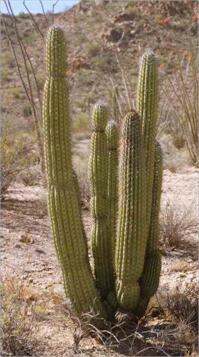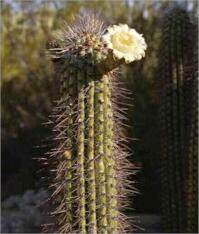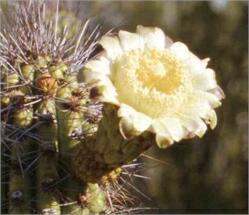ORGAN PIPE CACTUS (Stenocereus
thurberi)
The organ pipe cactus has several narrow, vertical stems which arise just above ground level, from a short trunk. At maturity the plant typically reaches a height of 3 metres. The stems rarely branch. Instead, they extend annually by regrowth from the tip, and each season's growth is marked by a constriction of the stem.
The older plants flower annually, producing large white blooms which open at night and close the next day. The many buds near the tops of the stems open on different days, so the flowering season can last several weeks. The flowers are pollinated mainly by bats. Organ pipe cactus is is sensitive to frost, so it is found mainly in Mexico (the state of Sonora, and the southern half of Baja California) and it extends only into the extreme south of the USA - notably in the Organ Pipe Cactus National Monument in Arizona, which was created to protect this plant at the northern limit of its range. It typically grows on rocky hillsides, up to about 1000 metres elevation, and not in the lower, flatter desert regions. Part of the reason for this is that cold air sinks into valley floors, so that frosts are more likely to occur there. The image above (which can be clicked for a larger version) clearly shows the habitat preference of this plant, because there is a distinct zonation of the larger cacti even on a local scale - the organ pipe cactus is seen growing on the hillside, whereas the old man cactus and the saguaro are growing in the flatter, sandier soil near the base of the hill.
Like all the large columnar cacti, the organ pipe cactus needs shade and protection for several years during its seedling stages, so the seedlings develop beneath "nurse trees". The evidence of this persists for many years (image above) until the extensive superficial root system of the cactus (confined largely to the upper 10 cm of soil) captures so much of the available water that the nurse tree may remain stunted or die. FOR PROFILES OF OTHER CACTI OR GROUPS OF CACTI - GO TO:
OR, GO TO: Cactus Gallery? |





